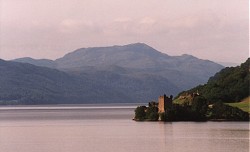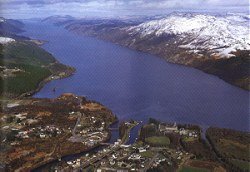Searching for Nessie (continued...)
Important Information Please Read First
All sighting and photographic references on this page are documented and can be verified through various publications.
Project Urquhart

Project Urquhart (named after the castle which stands on the shore of the loch ) was the idea of Nicholas Witchell the BBC news presenter and Loch Ness enthusiast since 1970.
He wondered if he could get the scientific bodies interested in studying loch ness and to his suprise they said yes. The Natural History Museum in London, the Freshwater Biological Association, Simrad the marine electronics company and the Discovery Channel all agreed either to help or sponsor work at the loch, not to search for the monster but to study the loch and its workings as the largest body of fresh water in the British Isles.
He wondered if he could get the scientific bodies interested in studying loch ness and to his suprise they said yes. The Natural History Museum in London, the Freshwater Biological Association, Simrad the marine electronics company and the Discovery Channel all agreed either to help or sponsor work at the loch, not to search for the monster but to study the loch and its workings as the largest body of fresh water in the British Isles.
The first stage, which took place in 1992 was carried out by the Simrad company using their research ship MV Simrad from Norway. They carried out the first complete hydrographic survey of the loch since 1903 when Sir John Murray plumbed the depths of the loch using nothing more than a long piece of pianowire and a weight.
Simrad travelled nearly 500 miles in the loch using the latest em1000 multi beam swath system which sends out 120 sonar signals at once in a pan beneath the boat taking a total of 7 million soundings.
Simrad travelled nearly 500 miles in the loch using the latest em1000 multi beam swath system which sends out 120 sonar signals at once in a pan beneath the boat taking a total of 7 million soundings.

A new maximum depth was found a couple of miles north of Invermoriston of 786 feet compared with the depth of 754 feet found by John Murray just south of Urquhart Castle and despite rumours that have been around for years no evidence was found of any caves or tunnels in the loch ( or Edwards Deep ). The loch proved to be a very regular steep walled trench.
While cruising the loch Simrad noticed a line of objects, dubbed the footprints, running from Foyers to Fort Augustus at about 60 metres apart. A small remotely operated submersible fitted with a video camera was sent down to look at one of them and it turned out to be a large metal wheel barrow. It is thought that they are calibration targets put down by the Ministry of Defence to test sonar, when sonar was in its early stages of development and they were using the loch for trials.
While cruising the loch Simrad noticed a line of objects, dubbed the footprints, running from Foyers to Fort Augustus at about 60 metres apart. A small remotely operated submersible fitted with a video camera was sent down to look at one of them and it turned out to be a large metal wheel barrow. It is thought that they are calibration targets put down by the Ministry of Defence to test sonar, when sonar was in its early stages of development and they were using the loch for trials.
July 1993 saw the arrival at the loch of the 65ft research ship Calanus and its support boat Seol mara. Calanus carried some of the most sophisticated sampling devices and fish detecting sonar ever seen on an inland freshwater loch before and was to clock up almost 200 hours of intense sampling of the loch.
What they found is that the loch did not quite act like they expected and several unusual features still can not be explained.
The northern end of the loch is more productive than the southern end so it would be expected to hold a denser population of phytoplankton (microscopic vegitation) but the next step in the food chain the zooplankton (microscopic lifeforms) and fish are more abundant in the southern end of the loch.
They thought that this may be caused by the deep water currents taking them towards the southern end or that the zooplankton may be feeding on material washed down from the rivers entering the loch at Fort Augustus. Even the vertical distributions of phytoplankton and zooplankton did not follow what would be expected with the zooplankton being found some distance below the phytoplankton. Also, the open water fish distribution was some what unusual with the bulk of the fish living between 20 and 30 metres in total darkness.
Trawling the loch produced around 200 fish from the epilimnon (top warmer layer) most of which were charr. This is a very small amount for a stretch of water the size of Loch Ness but what the open water area lacked the more localized areas such as river mouths and near the shore line more than made up for and passed what would be expected from far richer lakes.
Because of this we still have no figure for the amount of fish in the loch with estimates made by the loch ness project of between 27 and 30 tonnes being the last figures to be released.
What they found is that the loch did not quite act like they expected and several unusual features still can not be explained.
The northern end of the loch is more productive than the southern end so it would be expected to hold a denser population of phytoplankton (microscopic vegitation) but the next step in the food chain the zooplankton (microscopic lifeforms) and fish are more abundant in the southern end of the loch.
They thought that this may be caused by the deep water currents taking them towards the southern end or that the zooplankton may be feeding on material washed down from the rivers entering the loch at Fort Augustus. Even the vertical distributions of phytoplankton and zooplankton did not follow what would be expected with the zooplankton being found some distance below the phytoplankton. Also, the open water fish distribution was some what unusual with the bulk of the fish living between 20 and 30 metres in total darkness.
Trawling the loch produced around 200 fish from the epilimnon (top warmer layer) most of which were charr. This is a very small amount for a stretch of water the size of Loch Ness but what the open water area lacked the more localized areas such as river mouths and near the shore line more than made up for and passed what would be expected from far richer lakes.
Because of this we still have no figure for the amount of fish in the loch with estimates made by the loch ness project of between 27 and 30 tonnes being the last figures to be released.

The Natural History Museums part in 1993 was to find microscopic animals in the loch which most of us will never have heard of. The nematode worm is found everywhere in the world from the highest mountain to the deepest oceans living in the sand soil and sediments as well as in the tissues of plants and animals.
In all 41 core samples were taken with most of the worms found in the top 1 centimetre. In just one of the samples 274 nematode worms were found covering 27 different species and one of these the ethmolaimus sp being new to science now with a new home in the vaults of the Natural History Museum in London. The purpose of the study is to see which and how many of the worms live in the loch to give them some idea of how a large freshwater lake should be and to see what the changes in the climate could have on it.
This will help them with studies throughout the world into global warming and pollution . but of more interest to most of us are the unusual sonar contacts made in both 1992 and 1993.
In all 41 core samples were taken with most of the worms found in the top 1 centimetre. In just one of the samples 274 nematode worms were found covering 27 different species and one of these the ethmolaimus sp being new to science now with a new home in the vaults of the Natural History Museum in London. The purpose of the study is to see which and how many of the worms live in the loch to give them some idea of how a large freshwater lake should be and to see what the changes in the climate could have on it.
This will help them with studies throughout the world into global warming and pollution . but of more interest to most of us are the unusual sonar contacts made in both 1992 and 1993.
Although the project were not there to look for the monster they did, while using their sonar, see some large contacts in the loch that they could not explain.
On Tuesday the 28 of July 1992 at around 7pm the Simrad research ship was heading south between Foyers and Invermoriston when the automatic tracking sonar locked on to a target and held it for around 2 minutes. Thor Edland, the Simrad specialist who was operating the sonar at the time, described it as a very strong echo in comparison to the fish traces they had been recording.
During the 1993 operations the Simrad sonar aboard the Calanus recorded 4 sonar contacts in mid water.
Birnie Lees, the senior Simrad engineer who studies the traces described them as "strong high value targets ". One in particular he said was "far too large to be one of the lochs known fish". So the biological study of the loch has shown us that the loch does not behave like we would expect a loch of its size to.
On Tuesday the 28 of July 1992 at around 7pm the Simrad research ship was heading south between Foyers and Invermoriston when the automatic tracking sonar locked on to a target and held it for around 2 minutes. Thor Edland, the Simrad specialist who was operating the sonar at the time, described it as a very strong echo in comparison to the fish traces they had been recording.
During the 1993 operations the Simrad sonar aboard the Calanus recorded 4 sonar contacts in mid water.
Birnie Lees, the senior Simrad engineer who studies the traces described them as "strong high value targets ". One in particular he said was "far too large to be one of the lochs known fish". So the biological study of the loch has shown us that the loch does not behave like we would expect a loch of its size to.
The old question of "is there enough fish in the loch to feed a monster " is no nearer an answer.
A new mini monster has been found in the loch, but again sonar contacts have been recorded at the loch this time by people who were not even looking for the monster. Again the sonar screen shows us that something large is moving around in the depths of the loch that should not be in a freshwater loch in the middle of the Highlands of Scotland.


No comments:
Post a Comment